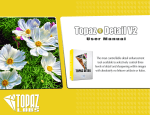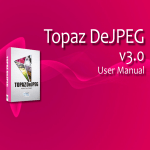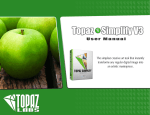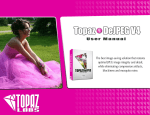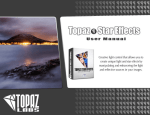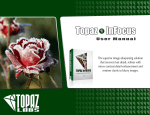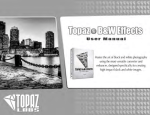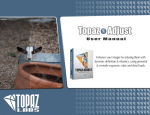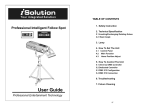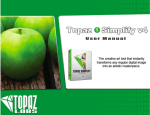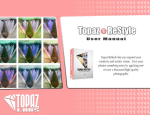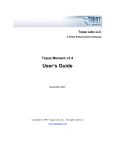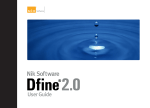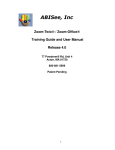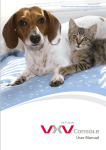Download Workflow - Topaz Labs
Transcript
Contents Topaz DeNoise User Manual I. Installation A. How to Install B. Entering Your Key C. Host-Specific Installation 1. Paint Shop Pro 2. Photo Impact 3. Irfanview 3 3 3 4 5 6 II. Introduction A. Noise 1. What is Noise? 2. Consequences of Noise 3. How to Spot Noise 4. What Causes Noise? 5. What is ISO? 6. Types of High ISO Noise? 7. Benefits of High ISO? 8. Side Effects of High ISO? 9. Noise Removal Tools? 10. When to use Noise Reduction? B. Topaz DeNoise 1. About Topaz DeNoise 2. Primary Functions of DeNoise 3. Banding Noise 4. Correcting Black Levels C. Your First Project D. New DeNoise Features 7 7 7 7 7 7 8 8 8 8 8 9 9 9 10 11 12 15 III. Work Area A. Interface B. Preview C. Presets 1. Applying Presets 2. Adding Presets 3. Deleting Presets 4. Importing Presets 5. Exporting Presets 6. Sharing Presets D. Tools E. Menu 1. Preferences 16 20 22 22 22 23 24 24 24 25 26 26 2. Enter Key 3. What’s This? 4. User Guide 5. Tech Support 6. Product Info 7. DeNoise Gallery 8. About 26 26 26 26 26 26 26 IV. Settings & Parameters A. Noise Reduction 1. Overall Strength 2. Adjust Shadow 3. Adjust Highlight 4. Adjust Color -Red 5. Adjust Color - Blue 6. Clean Color 7. Correct Black Levels B. Detail Recovery 1. Recover Detail 2. Reduce Blur 3. Add Grain C. Debanding 1. Horizontal (Checkbox) 2. Vertical (Checkbox) 3. Banding Width D. Using Raw Images E. Saving Raw Settings 27 27 28 28 28 28 28 28 28 28 29 29 29 29 29 29 30 31 VI. Work Flow A. Sample Project #1 B. Sample Project #2 C. Sample Project #3 D. Camera-Specific Presets 32 38 45 51 VII. Additional Resources A. Glossary B. FAQ’s C. Shortcut Keys D. Connect E. Company Info 54 56 58 50 51 2 Installation Topaz DeNoise User Manual Topaz DeNoise is a Photoshop plug-in, which means it won’t run by itself and requires a compatible host program. To Install 1. Close Photoshop or other image editing program if you are using it. 2. Open the Topaz DeNoise dmg or zip file, double-click on the Topaz DeNoise installer, and then follow the onscreen instructions. Mac Dmg Windows Zip 3. Your Topaz plug-ins will automatically be installed in your Photoshop plug-ins folder. 4. After the installation, you will need to enter your license or trial key. Important for Mac Users: After installation, Topaz DeNoise will be installed in the following folder: “ Macintosh HD -> Library -> Application Support -> Topaz Labs -> DeNoise 5”. If your Photoshop is installed in a customized location, you will need to manually create a shortcut (alias) link inside folder “<Photoshop install folder> -> Plug-ins” that links to “ Macintosh HD -> Library -> Application Support -> Topaz Labs -> DeNoise 5 -> Plug-ins”. Entering Your Key Entering your trial key allows you to save your processed images and print them during your evaluation period. Entering your license key allows you do the same, except without any time limitations. 1. Start by opening up an image in Photoshop. 2. Go to Filters -> Topaz Labs -> DeNoise 5 3. Once the interface opens, go to Menu -> Enter key. 4. You can then copy and paste or type your key in. Important: To install the product on a second computer, you will need to download Topaz DeNoise 5 and then enter your same license key. Host-Specific Installation Topaz DeNoise 5 is also compatible with Lightroom, Aperture and iPhoto. To use DeNoise 5 in any of these programs you will need to download and install the free Topaz Fusion Express 2 add on. You can get it online at: www.topazlabs.com/downloads In Windows, Topaz DeNoise 5 is supported by most host applications that support Photoshop plug-ins. This includes Paint Shop Pro, Photo Impact, Painter, and Irfanview, although there are other host programs that may also support Topaz DeNoise 5. To install DeNoise 5 in either Paint Shop Pro, Photo Impact, or Irfranview first download Topaz DeNoise to the default location. Then, to configure it into each program following the host-specific instructions on the next page. 3 Topaz DeNoise User Manual How to install Topaz DeNoise in Paintshop Pro 1. First launch PaintShop Pro. Installation 3. Choose C:\Program Files\Topaz Labs\Topaz DeNoise 5 plug-ins and click “OK”. 2. Go to Menu file -> Preferences -> File Locations. Select “Plug-ins” from the “File Types” list and click “Add”. 4 4. Topaz DeNoise 5 is now available to use. Simply go to Effects -> Plug-ins and select “Topaz DeNoise 5”. Topaz DeNoise User Manual How to install Topaz DeNoise in Photo Impact 1. First launch Photo Impact. 2. Go to File -> Preferences -> General or use shortcut key F6. Installation Then click on the button and browse to find the DeNoise 5 plug-in folder located in: C: \ Program Files \ Topaz Labs \ Topaz DeNoise 5 plug-ins and then click “OK”. 5 4. Restart Photo Impact. Go to Menu -> Effect to access plug-in. 3. Select Plug-ins from the Categories list. Topaz DeNoise User Manual How to install Topaz DeNoise in Irfranview 1. Make sure that you have downloaded and installed the 8bf plug-in add-on, available on the Irfanview webpage. (http://www.software.com/irfanview-plugin) Installation 3. In the screen that pops up, select “Add 8BF filters” and navigate to the C: \ Program Files \ Topaz Labs \ Topaz DeNoise 5 \ Plug-ins folder and click “OK”. You will then see “Topaz DeNoise 5” in the Available / Loadable 8BF Filters section. 6 2. Open Irfanview and go to Image -> Effects -> Adobe 8BF filters. 4. To use Topaz DeNoise 5 in the future, simply go to Image -> Effects> Adobe 8BF filters again and select “Topaz DeNoise 5”. Topaz DeNoise User Manual Introduction Noise What is Noise? Noise is a random and unwanted problem caused by the sensor (determined by your ISO settings) in digital cameras. Most often, noise appears as randomly spaced grain or dots distributed throughout your image. Noise can also appear as unevenness in color, random pixels of color or as a variation in brightness within your image. Noise is most noticeable in plain, solid areas of your digital image, and is also found in areas of high color and in darker areas such as blacks and shadows. Noise is also apparent in underexposed images. This is because lower light regions offer comparatively less visual information than regions with more light, so noise tends to become a problem in these darker settings. Brightening dark images can also increase the presence of noise in digital images. Consequences of Noise The presence of noise creates a visually unpleasant image with reduced image detail and clarity. Noise will also create an inconsistency in darker ares of the image such as blacks or shadows, leaving these areas looking grainy and often with random color specks. How to Spot Noise The true effects of noise may be hard to notice at first, but if you zoom in on your digital image - 200% or more - you will instantly see the defects. What Causes Digital Image Noise? Noise can be a result of a number of things including: 1. A very sensitive sensor 2. Low light combined with a high ISO. What is ISO? The ISO setting defines how sensitive your camera sensor is to the amount of light present in your scene. It can also vary by camera model. A higher ISO setting will cause the sensor to be more sensitive thus allowing you to take pictures in low-light or with faster shutter speeds. For more information and to see examples visit: www.topazlabs.com/denoise 7 Introduction Topaz DeNoise User Manual Two Types of High ISO Noise There are two general types of noise that you will see in your digital images: 1. Luminance Noise is the black and white noise or “grain” in an image. 2. Chrominance is the pastel-colored, speckled noise often seen in mid-tone or shadow areas. When Should I use Noise Reduction Software? The ideal time to remove noise is at the beginning of your workflow. Eliminating noise as a first step is key because it will ensure that you are working on a clean image. It is always important to remove any damaging defects before applying any color, detail or creative adjustments to your images. Uses and Benefits of High ISO Settings Generally, it’s always best to use the lowest ISO setting possible. However, a higher ISO enables: 1. Faster shutter speeds to freeze motion – ideal for indoor sports photography 2. Better performance in low light 3. Reduce image blur when shooting hand held Side Effects of High ISO Settings The side effect to a high ISO setting is noise. The presence of noise will reduce your image quality and obscure important subject details. 8 Before Topaz DeNoise Noise Removal Tools There are a variety of noise reduction tools available for eliminating image noise. However all tools come with the unwanted side effect of detail loss, which affects the overall quality of your image. Another common side effect is image blurring as a result of lost detail. These side effects lower the quality and value of your image. Topaz DeNoise uses the most advanced algorithm to preserve detail. After Topaz DeNoise Introduction Topaz DeNoise User Manual Topaz DeNoise About Topaz DeNoise Topaz DeNoise is an advanced noise detection and removal program that reduces noise while retaining an restoring image detail offering unprecedented control over the clarity of your photos. Topaz DeNoise specializes in reducing digital image noise, while preserving detail and increasing image sharpness. To connect with other Topaz users, participate in Topaz contests and to see the latest tips, tricks and tutorials sign up for the new Topaz Forum online at: www.topazlabs.com/forum The primary functions of Topaz DeNoise are: 1. Remove image noise 2. Retain and restore important image details previously obscured by noise. 3. Sharpen edges and color edges. 4. Smooth color unevenness. 5. Eliminate horizontal and vertical banding lines 6. Correct image black levels to restore true color in black and shadow areas. 7. Rescue underexposed images by removing the excessive noise that accompanies all brightening exposure adjustments. 8. Rescue low-light, high ISO images 9. Help users create high-quality JPEG images 10. Simplify the noise reduction process simple, making it powerful, quick, and efficient. Before Topaz DeNoise After Topaz DeNoise 9 Introduction Topaz DeNoise User Manual Banding Noise What is Banding Noise? Banding noise is a camera-induced artifact that appears in digital images as parallel patterns of horizontal and vertical lines. These lines often appear colorful. There are two forms of banding noise: short banding and long banding. Short banding noise appears in isolated image areas while long banding noise extends across the entire image. Banding is typically unpredictable and unavoidable, however it is more frequently seen with the use of high ISO speed. Before Topaz DeNoise DeNoise Debanding Technology Topaz DeNoise now features long banding removal capabilities. The new Debanding tab tackles both horizontal and vertical banding, eliminating the long colorful lines and restoring image integrity. Want to see more examples of banding noise and Topaz DeNoise’s new debanding technology? Visit the DeNoise website online at: www.topazlabs.com/denoise 10 After Topaz DeNoise Introduction Topaz DeNoise User Manual Correcting Black Levels Noise Effects on Image Black Levels Removing noise from dark and shadow areas of images affects the image’s black levels - often leaving a hazy color cast. This color cast can make your image appear desaturated and less contrasted in the dark areas. DeNoise 5 Black Level Correction The new Correct Black Level parameter in DeNoise 5 allows you to clean up this hazy color cast and restore the true richness of blacks and shadows in digital images. This unique color correction tool allows users to retain and restore balanced, contrasted color within images. Want to find out more information about noise reduction, banding, and black levels? Visit the Topaz Labs Blog online at: www.topazlabs.com/blog Before Black Level Correction 11 After Black Level Correction Topaz DeNoise User Manual Quick and Easy Noise Removal Topaz DeNoise makes noise remover quicker than its ever been, giving you clean and clear images every time. There are two main phases to noise reduction with DeNoise. Phase 1: Noise Reduction and phase 2: Detail Recovery. Setting the appropriate slider values in both of these phases is the key to achieving optimal image results. Your First Project We are going to show you how effective DeNoise 5 is and how fast it is to get optimal results in your images. You can denoise any image in 3 quick steps. Step 1: Click on the Reset All slider. If desired, select one of the default presets. Two optional steps include banding removal and black level color correction. However these adjustments are not always not necessary for every image. 12 Topaz DeNoise User Manual Your First Project 2. Go to the Noise Reduction tab and slowly adjust the Overall Strength slider to perfect the noise removal in your image. Then compare the before (Original) and after (Preview) of your image by clicking on the Original and Preview tabs or by using your spacebar shortcut key to toggle back and forth. You can also click on the preview image to toggle the views. 13 Your First Project Topaz DeNoise User Manual 3. Once you are satisfied with your changes click OK to process and you will have a clean, noise free image. 14 Before Topaz DeNoise After Topaz DeNoise And that’s all there is to it! You can quickly and easily remove noise from any image using DeNoise 5. Clear, clear and sharp images are always just a few clicks away. Now that you know how, go ahead try it out on your own images! Topaz DeNoise User Manual Introduction New DeNoise Features Topaz DeNoise 5.0 Features 1. Speed Increase. Now you can process images twice as fast. 2. Double the image size. Process images twice as large. 3. Debanding Tab. Horizontal and vertical banding noise is eliminated with the new dual-directional Debanding feature. 4. Correct Black Levels slider in the Noise Reduction Tab. Helps reduce haze (caused by noise) and reveal the true richness in the darkest parts of an image. 15 Before Topaz DeNoise Learn more about DeNoise features online at: www.topazlabs.com/denoise After Topaz DeNoise Work Area Topaz DeNoise User Manual Interface (Main View) Although the Topaz DeNoise interface may look intimidating at first glance, don’t worry: it’s actually quite simple and easy to use. You’ll soon be a pro after experimenting with it for a bit. In order to make sense of the function of each of the various controls, we have divided the interface into a few sections: 1 3 2 4 1. Presets 2. Preview Window 3. Preview Navigator 4. Settings and Parameters Provides “snapshots” of accessible pre-defined parameter settings. Displays the preview of the original and adjusted image. Displays the region of the preview image you are currently focused on. Controls the editing using sliders to adjust the various effects. 16 Topaz DeNoise User Manual Work Area Interface (Tool Panel View) Use the small white arrows to expand and collapse the preset panel. You can click the white arrow edge of the panel and drag it in or out. or grab the 17 Topaz DeNoise User Manual Work Area Interface (No Panel View) Use the small white arrows to expand and collapse the preset and tool panels. You can click the white arrows or grab the edge of the panels and drag them in or out. 18 Topaz DeNoise User Manual Work Area Interface (Preset Panel View) Use the small white arrows to expand and collapse the tool panel. You can click the white arrow edge of the panel and drag it in or out. or grab the 19 Work Area Topaz DeNoise User Manual Preview Section The Preview section is the main element that is centered in the DeNoise interface. The preview section shows you the original image and the processed preview of the image. Switch between the Original and Preview tabs to compare the filtered and un-filtered images. To pan the preview image, click and hold the left mouse button on the preview image and drag it around. When you let go of the mouse button, the new portion of the image will be processed and the result will be displayed. You can also use SPACE bar or click on the image to switch back and forth between your filtered and filtered image in the preview window. 1 20 Work Area Topaz DeNoise User Manual 21 You can zoom in or out of the preview image by clicking the “+”, or “-” buttons below the preview image. You can also resize the window as well by dragging the bottom right corner in and out. Please note: The minimum that you can zoom out is 100%. Anything below 100% hinders your ability to identify and remove image noise. The ideal zoom setting is 200% The “Ctrl +” and “Ctrl –” keys zoom in and out of the image, just like in Photoshop. You can use the arrow keys to adjust the value of the slider that is currently selected. A complete list of the shortcut keys can be found in the Shortcut Keys section later in this manual. Photoshop and other host software support many Image Modes, such as Grayscale, RGB, LAB, CMYK, etc. Images can also be 8, 16, or 32 bits per channel. Topaz DeNoise supports both 8 bits per channel and 16 bits per channel. Topaz DeNoise supports RGB mode only. To work on black-and-white images, first convert them to RGB mode. Work Area Topaz DeNoise User Manual Presets 1. Preset Info Box 1 Provides camera setting and profile information of the available pre-defined parameter settings included in the presets list below. Presets are a great way to speed up and simplify the whole process of using Topaz DeNoise. Presets are set previews with previously defined settings that you can recall and reapply at any time. We’ve included some default presets for you and, although they won’t work for every single photograph, they serve as excellent starting points for customized tweaking. 2 2. Presets List Lists all of the saved presets available for use. Applying Presets Applying a default preset is easy and intuitive. Simply clicking on a preset will change all the settings in Topaz DeNoise to match those in the selected preset. 3. Preset Options The preset options allow you to save your presets, delete presets (default presents cannot be deleted), import new presets and export your saved presets to share with your friends. To get the exact results you want, you may still want to go through the tabs and tweak the parameters. Adding Presets Sometimes it’s convenient to be able to define presets and save your settings for later use. To do this, first adjust the Topaz DeNoise parameters until you’re satisfied with the result. Then, click on “Save”. Remember that you can easily expand or collapse the presets panel by clicking on the small white arrow on the edge of the panel or by grabbing the panel edge and dragging it in or out. 3 22 Topaz DeNoise User Manual Then enter a preset name and select OK to save. It is also a good idea to use the other preset fields by entering a creator name, camera type, ISO setting, image type and a brief description of the preset. Work Area Your preset will be automatically saved as a new file with a “.tpp” extension in the Topaz DeNoise Presets menu and the preview is automatically generated. To apply it later, just click it like any other preset. You will also need to select a Relative or Absolute Preset Type. A Relative preset setting is generally used for broader types of image noise that require less precision. An Absolute preset setting is ideal for specific camera and ISO settings. For more information about these Absolute and Relative preset types please see page 45. Deleting Presets If you’d like to delete a preset the select the preset name and then click on Delete. Please Note: Default presents cannot be overridden or deleted. Once you delete a preset it or overwrite it when saving, then it cannot be retrieved. Note that if the name you’ve entered is the same as a preset you’ve already defined then you will be asked if overwrite the previous one. Saved presets are located in the Topaz DeNoise 5 “Presets” folder: C: \ Program Files \ Topaz Labs \ DeNoise 5 \ Presets unless you’ve opted to install Topaz DeNoise into a different directory. Mac users have this folder at Macintosh HD / Library / ApplicationSupport / TopazLabs / DeNoise 5 / Presets. 23 Topaz DeNoise User Manual Importing Presets To import a preset file, click the “Import” button. This will open up a “Browse” box to import a saved preset from your computer into Topaz DeNoise. This is useful if you have downloaded a preset file that you’d like to use. Work Area Exporting Presets To export the preset file to a certain location, click “Export”. Name your preset and save it to your desktop or other specified location that you have reserved for saved presets. 24 You can then share this preset file with others who may then import it. Sharing Presets Feel free to share your saved presets by emailing them to your friends and having them put it into their Topaz DeNoise Presets folder. Have more questions about Topaz DeNoise 5 or any of the other Topaz software programs? Check out the new Topaz Knowledge Base online at: www.topazlabs.com/support/kb Visit the Topaz Labs Blog which features the latest Photography, software and design information including tutorials, videos, and thoughts about both Topaz and non-Topaz topics. Work Area Topaz DeNoise User Manual Tools 1 You will use the various tools in the tools panel during your workflow to make your image adjustments. 1. Preview Navigator - Displays the region of the preview image you are currently focused on. 2. Zoom Buttons - Use the zoom buttons to zoom in and out of your image. 3. Preview Display Modes - View image noise based on the color channel that it is in. 4. Auto Brightness - add temporary brightness to your image to help you identify and remove noise. 5. Undo and Redo buttons - reverse and reapply image settings. 2 3 4 5 6 7 6. Snap & Recall buttons - save up to 99 snap shot settings for comparison. 7. Sliders and Parameters - Controls the editing process using sliders to adjust the various effects. 8. Reset All Button - Use the “Reset All” button to reset all of the sliders values back to zero. 8 25 Work Area Topaz DeNoise User Manual Menu Enter Key Select this to enter your trial or purchased license key. You can access Topaz DeNoise’s menu by clicking on the “Menu…” button at the bottom of the interface. What’s This? Select this (or click F1) then click on a feature in the DeNoise interface to learn more about it. Users Guide Select it to pull up this user guide. Tech Support Select to visit the Topaz Labs support page. Preferences Allows you to set the your startup parameter settings to Absolute or Relative. Relative is the default setting. Please see page 51 for more information. Product Info Select this to go to the Topaz DeNoise website. Gallery Opens your Internet browser and links to the Topaz DeNoise image gallery. About Displays your current version of DeNoise. 26 Settings & Parameters Topaz DeNoise User Manual Parameters Topaz DeNoise has three settings tabs and a total of 10 parameters, plus 5 display modes, to help you achieve optimal image results. Noise Reduction The Noise Reduction tab includes parameters that are related to noise removal. These tools are the main ones that you will use, and they will resolve most of your image noise issues. This is also where you will start when making any adjustments in DeNoise. All of the subsequent sliders are relative to the Overall Strength slider. 27 Overall Strength This is the main noise removal tool that reduces overall image noise that affects the entire RGB image. Overuse can soften the image so use with care. Before Topaz DeNoise After Topaz DeNoise For most users, “Overall Strength” is the only feature you will need to use when editing images that have noise issues. Be sure not to use too strong of a value with the “Overall Strength” slider or this may cause your image to lose detail and edge sharpness. Topaz DeNoise User Manual Adjust Shadow This parameter is relative to the Overall Strength slider and adjusts the noise removal strength in shadow (darker) areas of the image. Adjust Highlight This parameter is relative to the Overall Strength slider and adjusts the noise removal strength in the highlight (lighter) areas of the image. Adjust Color - Red This parameter works in conjunction with the “Red” Preview Display Mode, to reduce corresponding noise in that channel. Adjust Color - Blue This parameter works in conjunction with the “Blue” Preview Display Mode, to reduce corresponding noise in that channel. Settings & Parameters DeNoise offers 6 different Preview Display Modes that you can use to help with noise removal and detail recovery while using Topaz DeNoise. Enable the “Auto-Brightness” feature to brighten the image for better viewing of artifacts in dark areas. AutoBrightness is for previewing only, your image will not stay brightened once you process your adjustments. Detail Recovery The Detail Recovery tab offers additional tools that can help create a well-balanced image. This is where you will do your fine-tuning by restoring image details. Clean Color Controls the relative amount of color. Raising this value helps to correct images that contain random bits of color. Correct Black Levels Restores the true richness of blacks and shadows. Raising this value increases the saturation of black levels in your image. The Adjust Shadow slider coincides with the Correct Black Levels slider. As you increase the value of the Adjust Shadow slider you are removing more noise from shadow areas and exposing more black / shadow areas. This offers the Correct Black Levels slider more black / shadow area to evaluate and restore richness to. Recover Detail Brings original details back into the image. A good way to use this parameter is to first set it to “0”. Then after you have made your noise reduction adjustments, you can gradually increase this parameter to bring back more detail. Overuse can reintroduce noise into your image, so use with care. 28 Topaz DeNoise User Manual Reduce Blur This parameter is an intelligent de-blurring function that is useful for correcting blurry or soft edges after removing noise. This parameter should not be set higher than necessary because that may result in edge halos and noise amplification. Settings & Parameters Debanding The debanding tab allows you to remove horizontal and / or vertical banding from your image. Add Grain Adds fine monochromatic grain to the image for a lightly textured and natural look. Horizontal (Checkbox) Selecting this option targets the horizontal banding in your image. Vertical (Checkbox) Selecting this option targets the vertical banding in your image. Banding Width Determines how much debanding strength is applied to the selected direction. There are two types of banding noise that appears in images: short banding and long banding. For more information about noise reduction, debanding and example images please visit the Topaz Blog online at: www.topazlabs.com/blog Short banding appears in isolated areas of the image. Long banding extends across the entire image from end to end. The Debanding tool in Topaz DeNoise 5 targets only instances of long banding. 29 Topaz DeNoise User Manual Working with RAW Images In this section we will show you how to prepare your RAW image for use in DeNoise 5. In order to get the best results with DeNoise we will need to disable the noise controls in Camera Raw. 1. Start by opening your RAW image in Photoshop. Your Camera Raw interface will automatically load. 2. Go to the Detail tab and disable the Noise Reduction feature by setting the sliders to 0. Workflow Please make sure that you do NOT change the size of your image. Images are best left at 16-bit. 3. After that, click Open Image to begin working with DeNoise. Tip: If you plan to use DeNoise often then it a good idea to save your “Open Raw” settings as a preset so that you do not have to manually disable the sliders each time. 30 Topaz DeNoise User Manual Saving RAW Settings Camera Raw allows you to save your image settings so that they can be reapplied to any image at any time. It is recommended that you do this because it will allow you to quickly disable the “Sharpening” and “Detail” settings in Camera RAW, so that you can beging editing your image with DeNoise. Workflow You can Save new Camera Raw defaults. This will automatically apply the defined settings to every image opened in Camera Raw. To do this, click on the Menu button and select Save Setting, then make your Subset selections and click Save. Now each time you open an image in Camera Raw these default settings will be applied. 31 Workflow Topaz DeNoise User Manual Sample Project #1 In this section, we will walk you through a sample project, step-by-step, to help you become more familiar with the DeNoise program and how you incorporate it into your post processing workflow. We will be using this noise-damaged image for our example. The goal for this image is to remove noise while retaining and restoring obscured image details. In the following steps, we will show you how to achieve optimal results with your own photos, following this model. So, let’s get started. 1. After you make your Camera Raw selections, open your image file in Photoshop. 2. Go to Filter -> Topaz Labs and select DeNoise 5. 32 Before Topaz DeNoise After Topaz DeNoise Topaz DeNoise User Manual 3. Once your image loads, click the Reset All button, then use your zoom tools and preview navigator to focus in on a mid-tone area with a strong presence of noise. This will help you to easily identify noise, and it will make your subsequent adjustments easier to see. Please note: Mid-tone and shadow areas show noise the best. Workflow So again, what we want to do is improve the quality of this image by removing the color noise that is obscuring the window, building and tree detail. To achieve this we will be working with the Presets and then adding in some additional manual adjustments, but you can start any way you like. 33 Topaz DeNoise User Manual 4. If you want to choose a default preset, scroll through the panel on the left side of the screen. Be sure to try out each of the presets until you find the one that works best for your image. 5. Click on the preset name to select it and the predefined settings will be applied to your image. Workflow For this image we will be using the “Raw with moderate noise” preset. Tip: Use the preview navigator to pan and Preview Display Mode options to look at every aspect of your image to be sure that you are happy with the settings before moving on to manual adjustments or processing. 34 Workflow Topaz DeNoise User Manual 6. If you are satisfied with the preset adjustments then you can click “OK” to process your image and save it back to Photoshop. And that’s it. Your image is now clean, clear and noise free. Tip: Save your settings as a preset before processing. This will allow you to recall the settings and apply them to any image taken at that same ISO on your camera - saving you lots of time later on! Please visit the Topaz DeNoise website at http://www.topazlabs.com/DeNoise for video tutorials, tips, and tricks! 35 ***Split screen preview is NOT available in DeNoise 5 and is only used here for comparison purposes.*** Workflow Topaz DeNoise User Manual 36 Before Topaz DeNoise Workflow Topaz DeNoise User Manual 37 After Topaz DeNoise Workflow Topaz DeNoise User Manual Sample Project #2 In this project, we will walk you through a second DeNoise workflow. In this example we will focus on the optimal way to remove noise from a jpeg image. We will be using this photo of a pair of boots for our example. Jpeg images are compressed and typically have less ‘fine” noise. This means that we will be able to apply a higher Overall Strength slider value. This jpeg image is covered with noise and pixels of color that are obscuring detail and distorting color in the young lady’s boots. Our goal here is to remove these defects and smooth out the color in the boots. We will be manually adjusting the sliders to remove the image noise, but you are welcome to start any way you like. Let’s get started. 1. To begin working on your image go to Filters -> Topaz Labs and select DeNoise 5. 38 Before Topaz DeNoise Before Topaz DeNoise Topaz DeNoise User Manual 2. Once your DeNoise interface opens, click the Reset All button located in the bottom right hand corner of the interface. This will set all of the sliders to their default values. You will always want to start with the default values when making manual adjustments. Need to reset only one slider value? Double-click on the slider name above the slider control to instantly reset the slider value to it’s default value. Workflow 3. Use the zoom and preview navigator (or hand tool) to focus in on a specific part of your image. You will want to focus in on a mid-tone area as it will best display the noise present in your image. Tip: Set the Auto-Brightness feature to normal or strong in order to better see the noise in your image. 39 Topaz DeNoise User Manual 4. Starting with the Noise Tab, adjust the Overall Strength slider. This will eliminate most of the noise in your image. Be sure not to over use this slider. Doing so will over-smooth your image. Workflow Tip: As you are making adjustments with the Overall Strength slider, be sure to monitor your adjustments in both the RGB and Luma Preview Display Modes which directly correspond with that slider. Don’t forget that you can use the shortcut keys in Topaz DeNoise to speed up your workflow. 40 Topaz DeNoise User Manual If your image has vivid shadowed or highlight areas with noise, then you will also want to use the Adjust Use of these sliders is not always necessary and will depend on your image needs. Workflow You will also want to adjust your Adjust Shadow and Adjust Highlight sliders while in the Luma preview display mode. 5. Focus in on a dark area of your image to begin making adjustments with the Shadow Area slider. The best way to get great-looking images is to experiment with the filter until you’re satisfied. Despite the number of sliders and settings, getting a great result is easier than you might think! 6. Focus in on a light area of your image to begin making adjustments with the Highlight Area slider. 41 Workflow Topaz DeNoise User Manual 7. Switch to the Red preview mode to adjust the noise level in the Red Channel. You will use the Adjust Color - Red slider to do this. Before you adjust the slider, use your spacebar shortcut key to preview the original image so that you can see how the red noise is displayed Then proceed to increase or decrease the slider. 8. Switch to the Blue preview mode to adjust the noise level in the Blue Channel. You will use the Adjust Color - Blue slider to do this. Before you adjust the slider, use your spacebar shortcut key to preview the original image so that you can see how the blue noise is displayed. Then proceed to increase or decrease the slider. 42 ***Split screen preview is NOT available in DeNoise 5 and is only used here for comparison purposes.*** Topaz DeNoise User Manual 9. After making your adjustments, you may notice random or faint blocks of color in your image. You can slightly increase the Clean Color slider to remove the color blocks and balance the color in your image. Workflow reintroduces original details back into the image that were suppressed during noise removal. Over applying this parameter will reintroduce noise and sometimes color unevenness back into your image, so use with care. 12. Next, we will work on the sharpness of the image using the Reduce Blur slider. Pan to an area in your image that has sharp edges and then slowly adjust this slider to improve edge visibility. For this image, we will focus in on the edges of the young lady’s boots. As you adjust this slider you will notice the lines and edges becoming clearer and more distinct. 13. You can also increase the add Grain slider to add texture to your image to keep it looking natural. The other benefit of using grain is that it is small and monochrome. Meaning that there will not be any color side effects. However, we will not be adding any for this image. 10. The presence of noise often leaves a red or blue color cast over your image. Increase the Correct Black Level slider to restore the color richness in the black and shadow areas. Now we are ready to move onto the Detail Recovery Tab. The adjustments made here will allow us to recover image detail, reduce image blur and enhance edges and lines. 11. Slowly adjust the Recover Detail slider. This slider 14. Compare the Original and Preview of your adjusted image using the tabs, your spacebar shortcut key or by clicking on the preview image. Once you are happy with your settings you can click OK to process your image and save it back to Photoshop. 43 Workflow Topaz DeNoise User Manual And that’s it! You should now have a clean, noise free image that is ready for any additional color, detail or creative adjustments that you have in mind. 44 Before Topaz DeNoise After Topaz DeNoise Workflow Topaz DeNoise User Manual Sample Project #3 1. To begin working on your image go to Filters -> Topaz Labs and select DeNoise 5. In this project, we will walk you through a third DeNoise workflow that includes debanding and black level color correction. We will be using this night shot as our example. As you can see, in addition to noise, this image also has a red color cast and slight banding noise. Our goal here is to remove these defects and restore the image color. 2. Once your DeNoise interface opens you can use the zoom and preview navigator (or hand tool) to focus in on a specific part of your image. You will want to focus in on a mid-tone area as it will best display the noise present in your image. We will be manually adjusting the sliders to remove the image noise, but you are welcome to start any way you like. Let’s get started. 3. Click the Reset All button located in the bottom right hand corner of the interface. This will set all of the sliders to their default values. You will always want to start with the default values when making manual adjustments. 45 Before Topaz DeNoise After Topaz DeNoise Topaz DeNoise User Manual 4. Change the preview mode to Luma, which will show just the luminant information. 5. Use the zoom and preview navigator (or hand tool) to focus in on a specific part of your image. You will want to focus in on a mid-tone area as it will best display the noise present in your image. Workflow 6. Go to the Noise Reduction tab and adjust the Overall Strength slider. This will eliminate most of the noise in your image. Tip: The Overall Strength slider value is key to getting optimal image results. If you use too strong a value the image will become very smooth and too soft. Too small a value will leave a lot of noise residuals. 46 Topaz DeNoise User Manual 7. Pan to a dark / shadow area in your image. You can turn on the auto brightness feature which will allow you to better identify the noise in your image. Increase Adjust shadow slider and it will reduce the noise in shadow areas. 8. Pan to a highlight area of your image and look for noise. Generally, highlight areas do not usually need a lot of noise reduction. Workflow If you need to remove more noise then increase the slider value here. If you see too much smoothing or a loss of detail in the highlight areas then reduce the Adjust Highlight slider value. Details are all in the luma channel, so we will make detail adjustments next. 47 Topaz DeNoise User Manual 9. Go to the Detail Recovery Tab and slowly increase the Recover Detail slider. This will reintroduce original details back into the image that were suppressed during noise removal. 10. Next, we will work on the sharpness of the image using the Reduce Blur slider. Focus on an area in your image that has sharp edges and then slowly adjust this slider to improve edge visibility. Workflow 11. You can also increase the add Grain slider to add texture to your image to keep it looking natural. 12. Go to Red Preview Mode to see red color information. Increase the Adjust Color - Red slider to suppress more of the red noise. 13. Go to Red Preview Mode to see red color information. Increase the Adjust Color - Blue slider to suppress more of the blue noise. 48 Topaz DeNoise User Manual Tip: You can also use the Adjust Color - Red and Adjust Color - Blue sliders to help balance color in your image. 14. If you notice blocks of color noise in your image, you can use the Clean Color slider to remove them and smooth out the color in your image. Change back to the RGB color mode to help you see the effects of this. Workflow 15. Remove horizontal and vertical banding noise using the debanding tab. Select the direction of the present banding noise and then slowly adjust the Banding Width slider to remove it. 16. If you notice a leftover hazy color cast the go to the Noise Reduction tab and Increase the Correct Black Levels slider to clean up the haze and restore the black levels in your image. 49 Workflow Topaz DeNoise User Manual 50 Before Topaz DeNoise After Topaz DeNoise Topaz DeNoise User Manual Camera-Specific Presets In this section we are going to show you how to create your camera-specific presets. DeNoise 5’s advanced technology allows you to create preset profiles for your camera type and various ISO settings. This capability is extremely valuable because it will allow you to easily process your images shot with specific ISO settings. Workflow Step 2. Create the Preset Profiles We are going to edit each image in DeNoise starting with the 12800 ISO shot (or whichever is the highest that you shot). 1. Open your RAW image in Photoshop and invoke DeNoise (don’t forget to disable the Camera Raw settings. See page 30 for more instructions). 2. In DeNoise, go to Menu -> Preferences and change the Parameter Setting at Startup to Absolute. Creating camera-specific presets is a two-step process which includes taking shots at different ISO’s and then using each shot to create your default preset for that ISO setting. 51 Step 1. Take the shots You will need to take your shots. We recommend the following ISO’s: 200, 400, 800, 1600, 3200, 6400 and 12800. If desired you can include 100 and 25600 or omit any of the previous ISO’s that you do not typically use during shooting. The Absolute and Relative parameter settings determine how the parameter settings from your previous DeNoise session are viewed. Under the Absolute setting, when you open DeNoise the slider values and noise removal will be set at the same exact values that were applied to the last image you processed with DeNoise. This is ideal if you plan to do batch processing and you have multiple images with the same ISO and characteristics. Under the Relative setting, when you open DeNoise the slider values will shift and give you an estimate of the image and noise settings based on your last session. Topaz DeNoise User Manual Workflow 3. We will start with the 12800 ISO shot (or whichever is your highest ISO shot) and begin the noise removal process. Pan your image and find a mid-tone area to work on. 4. You can select one of the default presets or you can start manually, using the Overall Strength slider found in the Noise Reduction Tab. Slowly work your way down through each slider gently making adjustments until you are happy with the results. As you are making your slider adjustment keep the following workflow tips in mind: 1. Find a mid-tone area to focus in on. This will help you to easily identify and remove noise. 2. Use the Auto-brightness feature to make noise more visible. 3. Switch between the various Preview Display Modes and pan your image as you are making adjustments. 4. Toggle between your Original and Preview image to see the changes. Use the spacebar shotcut for this. 5. Once you are happy with your selections click on the Save button at the bottom of the Presets panel to save your new 12800 ISO preset. 6. Enter all of your Camera and image information, and set the Preset Type to Absolute. 52 IMPORTANT!: Make sure that when saving your preset that you save the Preset Type as Absolute. 7. Click OK to save your preset. Your new 12800 ISO preset should be listed in your Presets Panel. Now that we have created our first preset we can move on and create the others. Because we started with the highest ISO setting, this is actually going to make creating the lower ISO’s a breeze. 1. Open your 6400 ISO image and invoke Topaz DeNoise. 2. Pan to a mid-tone area of the image and then apply your 12800 ISO preset. Topaz DeNoise User Manual Workflow 3. Slightly adjust the Overall Strength slider to a lower setting. This should be minimal and is generally the only change that you will need to make. 4. Switch Preview Display Modes and toggle between your original preview and adjust preview to achieve optimal results. 5. Once you are happy with your settings click on the Save button at bottom of the Presets Panel to save your new 6400 ISO preset. You will continue on in this pattern working your way down to your lowest ISO setting. Each ISO preset made will be the starting point for the next preset you will make, and you should only need to adjust the Overall Strength slider as you go along. So, as you load each lower ISO image into DeNoise, make sure that you are selecting the most recent preset made for the ISO above to use as your starting point. Once you finish your last ISO profile, you will have a complete noise reduction set based on your camera and ISO settings. These new presets will definitely come in handy during your post processing and will help you to further increase the speed and ease of your noise reduction workflow. 53 Topaz DeNoise User Manual Achromatic - Without color. Action - A set of edits or adjustments that are recorded and remembered by Photoshop and can be played back later on any image. Algorithm - Any bit of code or programming that defines a process. Auto-brightening – Temporary visual setting that brightens the preview image, allowing noise to become more visible during removal. Brightness will not be permanently applied to image. Banding Noise - Banding noise is a camera-induced artifact that appears in digital images as parallel patterns of horizontal and vertical lines. These lines often appear colorful. Glossary Color channel - The visual component of a color digital image that represents all the pixels in that picture made up of a specific primary color. In a typical digital photo, the primary colors of red, green and blue (from the RGB color model) create all the colors in that photo, which may be represented by three color channels, each of red, green or blue. Color Noise – A type of digital noise in which color edges are blurred or the image is unevenly colored and filled with spots. Color Profile - defines the range of colors that can appear in a digital photo. Debanding - Removing banding noise from images and restoring image color and detail. DeBlur - A method for reducing image blur while sharpening image details. Batch Processing - The automated process of editing multiple images with the same adjustments and corrections. Download - The process of transmitting or transferring data from one device to another. Blur - Make or become unclear or less distinct. Export - Outbound data transfer in a format that can be used by other programs. Brightness - The degree to which a color sample appears to reflect light. Chroma - Purity or intensity of color. The difference of a color against the brightness of another color that appears white under similar viewing conditions. Color - The human perceptual response to different wavelengths of light impinging on the photo receptors in the retina. Grain –Lightly speckled noise that is used to apply a more natural look to an image. Image - An array of pixels that make up a digital picture. Import - Inbound data transfer into a file or document. ISO - The amount of sensitivity of a digital camera sensor. A higher ISO enables faster shutter speeds and/or 54 Glossary Topaz DeNoise User Manual better performance in low light, but is more susceptible to experiencing increased noise. Luma (Luminance) - The brightness in an image (the “black” and “white” or achromatic portion of the image). Luma represents the achromatic image without any color, while chroma components represent the color information. Noise - Visible effects of interference in an image from a digital camera. Often appearing as random colored dots sprinkled throughout the image or uneven coloration in what should be smoothly-colored areas. It is most likely to show up in the darker or shadowed areas of an image. Noise can be an undesirable effect that detracts from overall image quality or something you can choose to create artistically. Pan and Zoom - A useful function that allows users to magnify the captured image in the preview and then, by using the cursor, to move or pan around the image. Typically Pan and Zoom allows users to magnify the image 2x or 4x time. By magnifying the images and zeroing in on a specific section, you can see details not visible when the entire image is sized to fit the preview. Parameter - A numerical or other measurable factor forming one of a set that defines a system or sets the conditions of its operation. Photo-editing or Imaging software – Programs in which you can alter your photos and / or create digital images. Depending on the software, you can improve exposure, color and other attributes of your picture, paint on it, add type, apply special effects, remove noise, resize it, combine it with other pictures, prepare it for e-mail or posting on the web, output it to a print- er, or do any number of other manipulations or edits. Plug-in - A computing feature with the ability to be added to a system to give extra features or functions. Preset - A pre-defined combination of parameters and settings that is saved into a folder within Topaz DeNoise. Topaz provides default presets. A preview of each preset can be seen in the preset preview window located at the top left hand side of the interface above the preset list. Preview- Shows the processed preview of the image. RAW image - An image file format that contains untouched, “raw” pixel information straight from the digital camera’s sensor. It has yet to translate the information in each pixel into the full color information, so this format offers more control over how the final JPEG or TIFF image is generated. Reduce Blur - An de-blur function that uses deconvolution technology rather than simple sharpening techniques. Refine – Improve (something) by making small changes to make it more subtle and accurate. RGB - Red, Green, Blue. The color model that is used in digital cameras and by computer monitors. Sharpness - The clarity of detail in a photo. Smoothing - To make a surface more regular or consistent; free from perceptible projections, lumps, or indentations. Shadow - A dark area or shape produced by a body coming between rays of light and a surface. 55 Topaz DeNoise User Manual “I need a Topaz DeNoise trial key.” Visit http://www.topazlabs.com/downloads for a trial key. Please check your Spam folder because your Spam filter sometimes filters out the automated email. If you need more time to evaluate, please contact us at: www.topazlabs.com/support “I can’t find Topaz DeNoise in the Photoshop Filters menu.” If you’re using Windows: 1. Go to C: \ Program Files \ Topaz Labs \ Topaz DeNoise 4 \ Plugins. Right click the file “tlDeNoise5.8bf” and click “Copy”. 2. Go to your Photoshop Plug-Ins folder, usually located at C: \ Program Files \ Adobe \ Adobe Photoshop CSx \ Plug-Ins. First, delete anything that is currently there that has to do with Topaz DeNoise 5 This includes any folder that might be labeled “Topaz DeNoise 5” or any tlDeNoise5.8bf file. After doing that, right-click on any empty space and click “Paste”. 3. Quit and restart Photoshop and Topaz DeNoise will appear in your Filters menu. If you’re using Mac: 1. Go to Macintosh HD / Library / Application Support / Topaz Labs /DeNoise5 / Plug-ins and right-click Topaz_ DeNoise5.plugin. Click “Copy”. 2. Go to Applications / Adobe Photoshop CSx / Plug-Ins (or wherever your Photoshop Plug-Ins folder is located). Delete any current reference to Topaz DeNoise 5. Afterwards, right-click any Frequently Asked Questions empty spot and paste the Topaz_DeNoise5.plugin file into the Photoshop Plug-Ins folder. 3. Quit and restart Photoshop and Topaz DeNoise 5 will appear in your Filters menu. “Do you have any other DeNoise tutorials?” Yes, please see pages 32, 38 and 45 of this Topaz DeNoise user guide. You can also visit: http://www.topazlabs.com/tutorials/DeNoise for additional tutorials and DeNoise resources. “I do not have Photoshop, will DeNoise work with my Elements, Aperture, Lightroom, iPhoto Paint Shop Pro, Photo Impact or Irfanview?” Yes, you can use Topaz DeNoise with any of the above host programs. However, to use DeNoise in Aperture, Lightroom or iPhoto, you will need to download the free Topaz Fusion Express add-on. For more information please visit: www.topazlabs.com/fusion “What are the limitations of the trial version of your software?” The only limit on the trial versions of the Topaz plug-ins is time. The free trial versions are designed to enable you to experience the full functionality of our plug-ins for a 30-day trial period. After the trial period is up, you will only be able to use the Topaz software by purchasing it. You will then receive a license key to activate the plug-in, and the trial version will automatically become the full version with no time limitations. 56 Topaz DeNoise User Manual “If I use the 30-day trial version will I need to uninstall the trial version before I upgrade to a full version?” No, the Topaz trial software is designed to be unlocked to become the full version simply by entering a license key. The full license key will be e-mailed to you immediately after you purchase the software. “Where do I enter my key?” To enter your key please open an image in Photoshop and go to Filter -> Topaz Labs -> DeNoise 5 -> Menu -> Enter Key. You can then copy & paste or type in your license key and then select OK. “I had Topaz DeNoise as a trial, then I purchased. How do I enter my new license key?” You can enter your new license key by opening up an image in Photoshop and go to Filter -> Topaz Labs -> DeNoise 5 -> Menu -> Enter Key. Please remove the trial key and enter your new purchased license key, then select OK and you are all set. “My Topaz DeNoise key doesn’t work!” There are a couple of reasons why Topaz DeNoise might think your license key is invalid. First, make sure that your key is in the proper format. It’ll be in the format “xxxxxx-xxxxxx-xxxxxx-xxxxxxxxxxxx” and will be all numbers in 30 digits in five groups of six (no letters). Second, make sure that as you’re entering the key Frequently Asked Questions there is nothing in the space beforehand. This means clicking, pressing Ctrl-A, and hitting delete to make sure that absolutely nothing is in that field before you paste in the key. If it doesn’t work when you copy and paste, try typing it out, and vice versa. My Topaz filters are grayed out in the filter menu. Please make sure that you are using a 8-bit or 16-bit image that is in RGB color mode. This will allow you to access your Topaz programs. I have a question not listed here. Please visit our knowledge base online at: http://www.topazlabs.com/support/kb/ If you are not able to find the answer there then please visit our new Topaz Forum online at: www.topazlabs. com/forum or contact us at: www.topazlabs.com/support 57 Shortcut Keys Topaz DeNoise User Manual Topaz DeNoise 4 offers the use of shortcut keys to help speed up your workflow. Many of these keys are similar to the ones used in Photoshop. The following keys work at all times: MAC Shortcut Spacebar CMD-ALT-R + or CMD - + - or CMD - - CMD -Z CMD - Shift - Z PC Shortcut Action Spacebar CTRL-ALT-R + or CTRL - + - or CTRL - Ctrl - Z Ctrl - Shift - Z View Original Image Reset All Zoom In Zoom Out Undo Redo N D G A L C R B X Y Z S CMD-Shift-P CTRL-Shift-P CMD-Shift-N CTRL-Shift-N CMD-1 CTRL-1 CMD-2 CTRL-2 Left or Right Arrow Key Return (enter) key [ key ] key Home Key End Key Double-click slider name Expands / Collapses Noise Reduction Tab Expands / Collapses Detail Recovery Tab Expands / Collapses Debanding Tab Switches to RGB Preview Mode Switches to “L” Preview Mode Switches to “C” Preview Mode Switches to “R” Preview Mode Switches to “B” Preview Mode Turns the Auto-bright feature off Sets the Auto-bright feature to Normal Sets the Auto-bright feature to Strong Takes a Snapshot Recalls previous Snapshot Recalls next Snapshot View Original Image View Adjusted Image Scrolls through presets Applies selected preset Reduces selected slider value by 0.1 Increases selected slider value by 0.1 Set the slider value to minimum Set the slider value to maximum Resets the slider to it’s default value Mac and PC Shortcuts are the same unless indicated otherwise. 58 Topaz DeNoise User Manual Connect with Topaz Check out our new Forum and our blog for tutorials, tips and updates from Topaz Labs! 59 Follow us on Twitter for notifications of recent news and easily get in touch with us whenever you feel like it! Find us on our Facebook page and network with other Topaz users! Participate in the entirely user-led Topaz Flickr group for a helpful and highly active community for Topaz Photoshop plug-ins! Subscribe to our YouTube channel to keep up with any newly released product video tutorials! Topaz DeNoise User Manual Contact Information Topaz Labs LLC 5001 Spring Valley Road Suite 400 East Dallas, TX 75244 Technical Support Visit: http://topazlabs.com/support/ 60 Topaz Labs LLC, a privately owned company in Dallas, Texas, focuses on developing advanced video and image enhancement technology. With today’s widespread use of digital still cameras, digital video cameras, and HDTV, the need for highquality digital images and videos has greatly increased. Topaz Labs’ mission is to bring practical state-of-the-art image and video enhancement technology to both professionals and consumers. Copyright © 2009 Topaz Labs, LLC. All rights reserved. http://www.topazlabs.com Topaz DeNoise User Manual Be sure to check out the complete line up of Topaz products. Image Plug-ins Advanced JPEG artifact reduction filters eliminate JPEG compression artifacts while preserving image detail like never before. 3 levels of intricate and specific detail enhancement for naturally enhanced images with no halos. Advanced noise reduction filters noise while maximizing and retaining image detail simply and effortlessly. Specializes in overall image improvement. Features sharpening, reconstructing, enlarging, high-quality noise removal and JPEG artifact damage tools. Remove unwanted backgrounds from your digital images quickly and easily with the new Topaz ReMask. Takes any of your regular photos and effortlessly turn them into beautiful works of art. Specializes in creating crisp and stylized images. Also features extensive smoothing capabilities. Ultimate control over image exposure, detail, and color gives you the power to make your photos pop. Bring the power of Topaz to your Aperture, iPhoto and Lightoom workflow with the new Fusion Express plug-in. Video Plug-ins Increase video quality with this suite of video enhancement filters utilizing super-resolution technology. Easily and efficiently capture video frames and significantly increase their quality and resolution with this standalone Windows application. Go to http://www.topazlabs.com/downloads to get your 30-day free trial! 61





























































